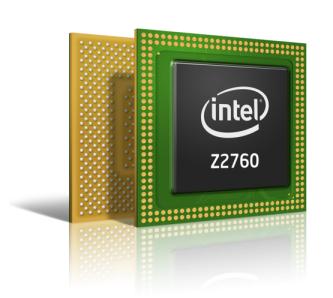
After months of heralding its Clover Trail processor for Windows 8 tablets, Intel on Thursday unveiled the chip that it believes is its ticket to success in the ARM-dominated market.
Tablets with Clover Trail, aka the Atom Z2760 chip, will become available around the end of October when Microsoft ships Windows 8, Intel officials said. The chip will facilitate long battery life for Windows 8 tablets and full HD video.
While Intel dominates the PC market, it faces a tough road in the mobile battle with ARM, whose processors ship in most smartphones and tablets including Apple’s iPad. Intel has high hopes for Windows 8, and has worked with Microsoft to take advantage of OS features to provide fast performance and long battery life in tablets.
Microsoft will release Windows 8 for Intel-based tablets and Windows RT for ARM-based tablets. Intel has said Windows 8 devices will have the advantage of supporting existing Windows applications and drivers, and users will be able to install existing Windows 7 programs and attach peripherals like printers and cameras. That could be an issue with Windows RT tablets, which may prove more popular with users who don’t need that ability. But Windows RT devices may have advantages in price and battery life.
Intel has a better chance to succeed in the tablet market with the touch-based Windows 8, said Dean McCarron, principal analyst at Mercury Research. Clover Trail’s predecessors were used in tablets running Windows 7, which was a desktop and not a mobile OS.
Intel’s primary goal with Clover Trail is to reduce power consumption in its tablet chips so it can catch up with ARM, whose processors were originally designed for smartphones and are considered more power efficient.
Clover Trail is faster and more power efficient than the previous Atom tablet chip, code-named Oak Trail, which appeared in just a handful of Windows 7 tablets starting in 2011. Clover Trail is made using an advanced, 32-nanometer manufacturing process, which made the chip smaller in size while reducing power leakage.
“With each generation the product becomes a better fit,” McCarron said. “They are doing everything they can.”
Device makers have already shown off upcoming tablets with the Clover Trail chip. Lenovoannounced the ThinkPad Tablet 2, while Hewlett-Packard announced the Envy X2, a PC with a detachable keyboard that turns into a tablet. Asus and Samsung have also announced Windows 8 tablets with Clover Trail. A prominent name missing is Microsoft, which has announced a Surface tablet model based on Intel’s faster but more power hungry Core processors and also a model with Windows RT.
Device makers have indicated the starting prices of Clover Trail could be around US$500 or higher, which is more than the iPad.
The Atom Z2760 is a dual-core processor that runs at 1.8GHz and has 1MB of L2 cache. Depending on the configuration, tablets with the Z2760 can include NFC and LTE capabilities, Intel said. Some of the image processing features were drawn from the Atom chip for smartphones code-named Medfield, which is now in handsets from companies including Lenovo, Motorola, Orange, Megafon, ZTE and Lava International.
Intel is open to making Clover Trail variants for device makers, said Steve Smith [CQ], director of tablets at Intel. The initial Clover Trail chips will be tuned to Windows 8, though the company wants to tune the Linux OS to take advantage of power-saving and graphics features on the chip. The company also offers Medfield for tablets, with those devices supporting Google’s Android.
Clover Trail will be succeeded next year by a tablet chip made using a 22-nanometer process, and by a 14-nanometer tablet chip in 2014.





